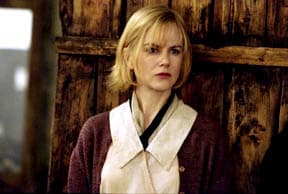Lars Von Trier is best known in film circles for having devised a half-joking manifesto called Dogme 95; in it, he outlined "rules" that would help save films from Hollywood formula. They included only using natural light, hand-held cameras, existing locations, natural environmental music (no score) and a vague "no clichés" rule. But despite this being his calling card, Von Trier himself has only actually made one film that adhered to the Dogme ideals: 1998’s The Idiots.
His lack of interest in exploring the potential of Dogme notwithstanding — for the most part leaving that to other filmmakers — Von Trier nonetheless remains fascinated with the storytelling form and how environment or other external factors can be manipulated in order to further strip bare the process of his filmic manipulations.
On the surface, Dogville seems like the most extreme of his experiments so far, simply due to the sparseness of its set. The film opens with an overhead shot of the small Colorado mountain town of Dogville and its two dozen or so residents. Yet the shot itself contains only a black soundstage, with the town’s layout painted, Les Nessman-style, on its black floor. Each of the houses, streets, gooseberry bushes and the abandoned mine are all indicated by stencils on the floor; sets are otherwise limited to single pieces of furniture: a desk, a couch, a bed.
Inspired by plays adapted for television in a sparsely theatrical style, and removed from atmosphere-enhancing (and potentially distracting) locations, Dogville relies on its cast of compelling characters to propel the dramatic action. The film, told as a prologue and nine chapters, follows the story of Grace (Nicole Kidman), a mysterious fugitive who seeks shelter from the cops and gangsters that pursue her. When she first arrives in the town, self-appointed spokesman Tom Edison (Paul Bettany) speaks on her behalf; in exchange for her labour, the town will shelter her.
As the film progresses, and it becomes more and more evident that Grace’s pursuers are tenacious, the town takes greater advantage of her predicament. While initially tentative in accepting her help, she soon becomes a slave — in physical labour and sexual favours — to many of the town’s residents.
Lars Von Trier’s two biggest films before this, Breaking the Waves and Dancer in the Dark, were morality plays concerning nobility in the face of extreme suffering; here he explores the depths of human cruelty. With a running time nearing three hours, it’s difficult viewing at times because, due to its sparse presentation, we’re tied to its characters, a hodgepodge of seeming innocents who are not paragons of virtue by any means. The film balances this darkness with moments of levity that burst out like nervous laughter at an execution.
Von Trier is dependent on his spectacular cast to execute a difficult dramatic experiment and it pays off; the list includes Lauren Bacall, James Caan, Patricia Clarkson, Jeremy Davies, Ben Gazzara, Philip Baker Hall, John Hurt and Udo Kier. While Kidman continues her streak of doing career-defining work, her supporting cast helps pull off a compelling, intense, avant-garde experiment in radical storytelling that digs deep into the darkness of the human heart. (Lions Gate)
His lack of interest in exploring the potential of Dogme notwithstanding — for the most part leaving that to other filmmakers — Von Trier nonetheless remains fascinated with the storytelling form and how environment or other external factors can be manipulated in order to further strip bare the process of his filmic manipulations.
On the surface, Dogville seems like the most extreme of his experiments so far, simply due to the sparseness of its set. The film opens with an overhead shot of the small Colorado mountain town of Dogville and its two dozen or so residents. Yet the shot itself contains only a black soundstage, with the town’s layout painted, Les Nessman-style, on its black floor. Each of the houses, streets, gooseberry bushes and the abandoned mine are all indicated by stencils on the floor; sets are otherwise limited to single pieces of furniture: a desk, a couch, a bed.
Inspired by plays adapted for television in a sparsely theatrical style, and removed from atmosphere-enhancing (and potentially distracting) locations, Dogville relies on its cast of compelling characters to propel the dramatic action. The film, told as a prologue and nine chapters, follows the story of Grace (Nicole Kidman), a mysterious fugitive who seeks shelter from the cops and gangsters that pursue her. When she first arrives in the town, self-appointed spokesman Tom Edison (Paul Bettany) speaks on her behalf; in exchange for her labour, the town will shelter her.
As the film progresses, and it becomes more and more evident that Grace’s pursuers are tenacious, the town takes greater advantage of her predicament. While initially tentative in accepting her help, she soon becomes a slave — in physical labour and sexual favours — to many of the town’s residents.
Lars Von Trier’s two biggest films before this, Breaking the Waves and Dancer in the Dark, were morality plays concerning nobility in the face of extreme suffering; here he explores the depths of human cruelty. With a running time nearing three hours, it’s difficult viewing at times because, due to its sparse presentation, we’re tied to its characters, a hodgepodge of seeming innocents who are not paragons of virtue by any means. The film balances this darkness with moments of levity that burst out like nervous laughter at an execution.
Von Trier is dependent on his spectacular cast to execute a difficult dramatic experiment and it pays off; the list includes Lauren Bacall, James Caan, Patricia Clarkson, Jeremy Davies, Ben Gazzara, Philip Baker Hall, John Hurt and Udo Kier. While Kidman continues her streak of doing career-defining work, her supporting cast helps pull off a compelling, intense, avant-garde experiment in radical storytelling that digs deep into the darkness of the human heart. (Lions Gate)
